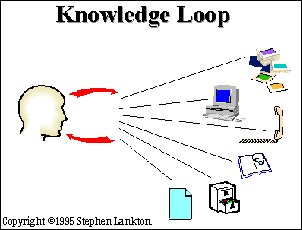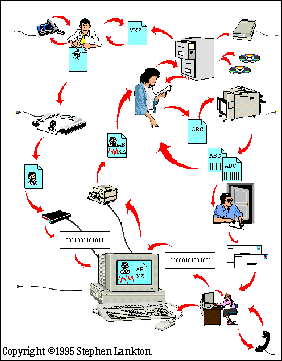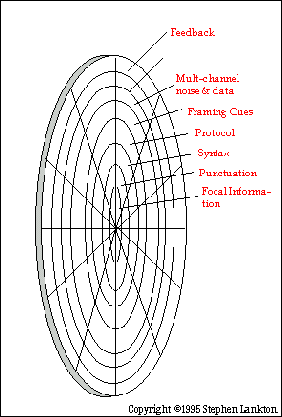![]()
![]()
| A. Introduction and Abstract | D. Emerging Paradigms | |
| B. The Current State | E. Corporate Partners | |
| C. The Invisible Resource |
![]() Knowledge Engineering and Interface
Management ScienceTM; can be defined as the application of expertise in
behavioral science, interface science, work process engineering, system
engineering, enterprise modeling, and graphical design to solve business
problems in the activity of knowledge exchange and decision making. Knowledge
Engineering pertains to improving how knowledge is exchanged. A Knowledge Loops
exists between people and knowledge-stores throughout each corporation. The
interface for that exchange follows rules that are improved with behavioral
science expertise. Knowledge GroupsTM and Knowledge MarketingTM supply
the input and output for Knowledge Engineering.
Knowledge Engineering and Interface
Management ScienceTM; can be defined as the application of expertise in
behavioral science, interface science, work process engineering, system
engineering, enterprise modeling, and graphical design to solve business
problems in the activity of knowledge exchange and decision making. Knowledge
Engineering pertains to improving how knowledge is exchanged. A Knowledge Loops
exists between people and knowledge-stores throughout each corporation. The
interface for that exchange follows rules that are improved with behavioral
science expertise. Knowledge GroupsTM and Knowledge MarketingTM supply
the input and output for Knowledge Engineering.
![]() Companies usually attempt to increase
productivity by expenditures to acquire hardware and equipment, or for employee
training, or process reengineering. Often, however, these efforts do not
actually increase profitability and often they allow companies to make the same
profitability mistakes more rapidly, redundantly, or more efficiently.
Companies usually attempt to increase
productivity by expenditures to acquire hardware and equipment, or for employee
training, or process reengineering. Often, however, these efforts do not
actually increase profitability and often they allow companies to make the same
profitability mistakes more rapidly, redundantly, or more efficiently.

![]() A major contributor behind failures to
increase profitability and continue wasted efforts is the lack of appreciation
for the fact that what any company really owns, regardless of which industry we
are speaking about, is knowledge. This is demonstrated by a repeated reliance
upon outdated and often unexamined interface systems and interfaces. After all,
the rapid and efficient exchange of knowledge is what actually drives business
decisions and creativity. That knowledge has to be exchanged between people,
databases, documents, machines, and commercial regulations. The result of that
exchange is the products and services the company sells and the manner in which
it sells them.
A major contributor behind failures to
increase profitability and continue wasted efforts is the lack of appreciation
for the fact that what any company really owns, regardless of which industry we
are speaking about, is knowledge. This is demonstrated by a repeated reliance
upon outdated and often unexamined interface systems and interfaces. After all,
the rapid and efficient exchange of knowledge is what actually drives business
decisions and creativity. That knowledge has to be exchanged between people,
databases, documents, machines, and commercial regulations. The result of that
exchange is the products and services the company sells and the manner in which
it sells them.

![]() Knowledge exchange - the knowledge loop -
between people and people, people and machines, machines and machines, back to
people, and even the private self-processing people do is recreated tens of
thousands of times per day in every corporation in the world. And yet, the lack
of attention given to methods of exchanging knowledge, the structure of the
delivery system, its features, and its efficiency is alarming. An interface is
a set of procedures that transform information from one system to become
information for another system. Interfaces need to provide the information
desired and needed in the manner, format, quantity, location, and time needed
for rapid and efficient decision making. Simultaneously, each system needs to
have the proper Communication Interface Strategy to employ those procedures in
the most effective manner for the companies need.
Knowledge exchange - the knowledge loop -
between people and people, people and machines, machines and machines, back to
people, and even the private self-processing people do is recreated tens of
thousands of times per day in every corporation in the world. And yet, the lack
of attention given to methods of exchanging knowledge, the structure of the
delivery system, its features, and its efficiency is alarming. An interface is
a set of procedures that transform information from one system to become
information for another system. Interfaces need to provide the information
desired and needed in the manner, format, quantity, location, and time needed
for rapid and efficient decision making. Simultaneously, each system needs to
have the proper Communication Interface Strategy to employ those procedures in
the most effective manner for the companies need.

![]() Knowledge Engineering and Interface
Management Science™ allows for a comprehensive reworking of all critical
knowledge paths within a company. It brings the range of ergonomic expertise to
bear upon collective corrective modeling, knowledge delivery system, interface
prototyping and generating, apprehending, representing, storing, retrieving and
processing for business solutions. Among these are the behavioral science
expertise providing a model and methods which are in actually clinical use,
guiding information exchange in serious and difficult case situations such pain
control, out-patient therapy, family therapy, hypnosis and brief therapy.
Successful information exchange in these extremely sensitive areas insures that
these methods of information exchange are valid and viable for critical
corporate interfaces.
Knowledge Engineering and Interface
Management Science™ allows for a comprehensive reworking of all critical
knowledge paths within a company. It brings the range of ergonomic expertise to
bear upon collective corrective modeling, knowledge delivery system, interface
prototyping and generating, apprehending, representing, storing, retrieving and
processing for business solutions. Among these are the behavioral science
expertise providing a model and methods which are in actually clinical use,
guiding information exchange in serious and difficult case situations such pain
control, out-patient therapy, family therapy, hypnosis and brief therapy.
Successful information exchange in these extremely sensitive areas insures that
these methods of information exchange are valid and viable for critical
corporate interfaces.
![]() Working as a corporate partner with larger consulting groups including Xerox (and others under non-disclosure
agreements) we provide a wide range of services including process reengineering, enterprise
financial modeling, knowledge exchange workshops, focus groups, electronic and
paper document reengineering, interface design, and behavior science
enhancements for internal and external communications, rapid learning, and
systems engineering.
Working as a corporate partner with larger consulting groups including Xerox (and others under non-disclosure
agreements) we provide a wide range of services including process reengineering, enterprise
financial modeling, knowledge exchange workshops, focus groups, electronic and
paper document reengineering, interface design, and behavior science
enhancements for internal and external communications, rapid learning, and
systems engineering.